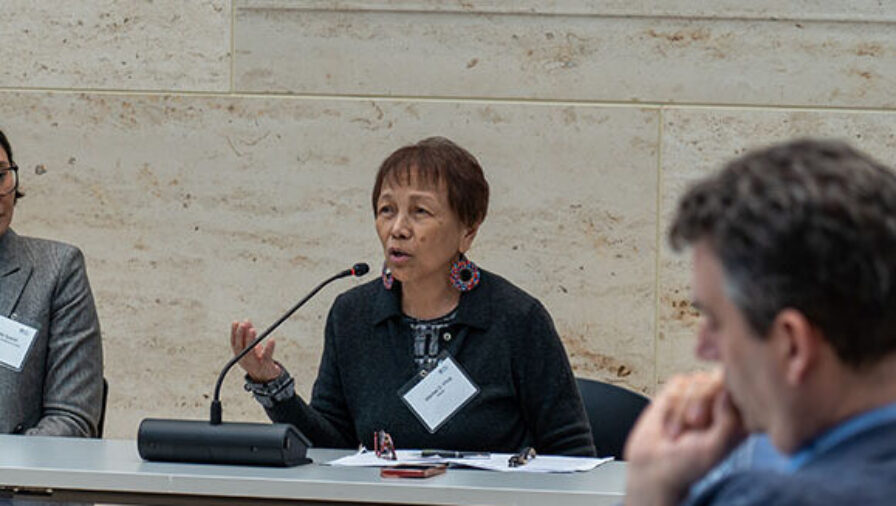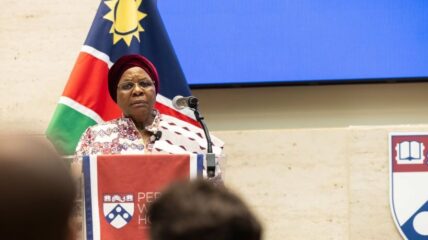The maritime dispute between the Philippines and China over the South China Sea has noisily spilled into the information space in what has become an intense battle of narratives. Despite the Philippines’ historic victory in an international arbitration court in 2016—which declared China’s nine-dash line claim as having no basis in international law, in particular UNCLOS or the UN Convention on the Law of the Sea—China has rejected this landmark decision, impervious to international law.
This is a case of a powerful authoritarian country using social and traditional media to expand its political influence on a democratic country, one that does not match its heft and clout. The Philippines values its democracy and a core principle of a healthy democracy is having a common set of facts—a set of facts that we share and agree on. Otherwise, we would be fragmented. We will not be able to have a conversation because our starting points diverge.
In 2022, under the administration of President Ferdinand Marcos Jr., Manila started to stand up to China, calling out its harassment and intimidation of Philippine Coast Guard and Navy vessels and personnel as well as Filipino fishermen in the West Philippine Sea (part of the South China Sea that falls within the Philippines’ Exclusive Economic Zone). China has responded, not only through its belligerent behavior in the seas, but through false narratives meant to weaken Filipinos’ resistance to China’s expansive claims.
This is precisely what China wants to happen. Together with a small group of Filipinos, considered proxies of China, it is spreading disinformation on social media and traditional media claiming that the international arbitral tribunal’s decision trashing China’s 9-dash line is false. China wants to shatter the facts that the tribunal laid out, our common set of facts. By making Filipinos question this common set of facts, they are dividing us to crumble our opposition to their aggressive actions.
Why does the information space matter to Beijing? China’s Communist Party under Xi Jinping equates a lack of voice with a lack of security. Xi’s focus on domestic and external security drives China’s obsession to assert itself abroad through propaganda and disinformation.
Threads of Chinese narratives
China employs a number of narratives that aim to discredit Philippine leaders and the country’s independence, the longstanding alliance of the Philippines and the United States, and civil-society groups opposing China.
By casting doubt on the Philippines’ independence, China undermines its strategic agency to decide for itself as well as support for Manila in the region. Enrique Manalo, the Philippines’ foreign affairs secretary, has said that China’s false narrative “paints the West Philippine Sea as merely a stage for Great Power rivalry in the region and that the Philippines is just a pawn in the game, and that we act only at the behest of another country.” The real crux of the issue, Manalo said, is that China “chooses to ignore international law…and the legitimate rights of…the Philippines.”
The troubles in the West Philippine Sea are not a result of U.S.-China rivalry. China took over features within the Philippines’ EEZ when the U.S. bases were no longer in the Philippines. In 1995, Beijing grabbed Mischief Reef and, in 2012, took control of Scarborough Shoal. China started to build artificial islands in 2013—before the Philippines and United States strengthened their alliance through the Enhanced Defense Cooperation Agreement signed in 2014.
China has likewise pushed its narrative of being a positive regional actor and has undermined U.S. leadership in an attempt to drive a wedge in U.S.-Philippine relations, according to a paper by the International Institute of Strategic Studies. The paper found that content of posts relevant to China-Philippine relations in the South China Sea highlight opposition to U.S. presence in the Asia-Pacific and praise for China’s naval accomplishments. They also promote figures who are not opposed to China’s position in the area.
Moreover, China has been sowing fear, intimidating Filipinos, warning of the consequences of our country’s legal actions in the West Philippine Sea, such as patrols and resupply missions. The message is: We should talk to China, meaning appease them, or the only other option is we go to war. This is a false choice.
This war narrative is also aimed at our officials, portraying them as war freaks. A deepfake audio of President Marcos urging Filipino soldiers to fight China demonstrated this. While it is not certain that China is behind this, a foreign actor is suspected by the government to be the perpetrator. (The video has since been taken down.)
Other videos on YouTube amplify the war narrative. One video claimed that Marcos declared war on China. The footage used in the misleading video was from the President’s speech during the Day of Valor where he urged Filipinos not to yield to those who present “clear and present threats to our sovereign rights.”
Clearly, China’s disinformation campaign seeks to cast doubt on Marcos’s leadership. The Australian Strategic Policy Institute (ASPI) has uncovered a covert social media campaign operated by the Chinese government that appears to be spreading a deepfake video seeking to undermine support for Marcos. ASPI identified a network of coordinated inauthentic accounts across X and YouTube amplifying a video of him appearing to take illicit drugs. This was circulated by supporters of former President Duterte hours before Marcos was to deliver a state-of-the-nation address on July 2024.
The latest target of China’s disinformation is a civil society group, Atin Ito! (This is ours!), which has led unprecedented humanitarian missions to the West Philippine Sea. These were widely covered by the international press, infuriating China.
In an investigation, Rappler, a leading news website, reviewed about 500 videos on social media produced by China claiming that Atin Ito! is secretly funded by the US and Philippine governments. China Daily, a state-funded media, was one of the sources of the videos.
However, their traction has been limited. Many of the social media posts of Filipinos on TikTok debunked China’s claim.
China-financed projects
China uses the development projects it finances to promote itself, portraying a positive image. An AIDDATA study found that China state-owned and state-influenced media focus their reports on the benefits of their projects to Filipinos while downplaying problems. Beijing likes to emphasize “win-win cooperation.”
In addition to media coverage, China officials, including ambassadors, write op-eds and issue public statements in local newspapers sympathetic to Beijing’s message. Beijing has increasingly relied on indirect messaging, using intermediaries to convey its narratives, AIDDATA pointed out, as trust and approval of the China in the Philippines have always been low.
China state media also forge content-sharing agreements with national media. For example, Xinhua provides free content to newspapers and news websites.
On social media, Beijing cultivates relationships with influencers on TikTok and Facebook but this has not resonated with local audiences.
China’s tactics
Certain patterns stand out in China’s disinformation in the Philippines. These are also present in other countries in the Indo-Pacific. A 2023 study by the International Republican Institute (IRI) showed that foreign proxies play a central role, China combines persuasion and coercion, and it repeatedly disseminates content in various platforms and from different sources.
Foreigners are tapped to tell China’s story. In the case of the Philippines, a number of Filipinos echo Beijing’s propaganda. The Chinese have a saying for this practice: “borrowing a mouth to speak” and “borrowing a boat to sail to the sea.”
The Philippine Center for Investigative Journalism (PCIJ) has reported that a number of local think tanks push pro-Beijing propaganda. Outside of think tanks, politicians (like former President Rodrigo Duterte and a few others) lead the Beijing proxies. Some businesspersons also echo pro-Beijing narratives.
Persuasion, for China, includes a range of activities, including sponsored trips to Beijing
In the area of coercion, one incident stands out. During the presidency of Benigno Aquino III (2010-2016), China banned bananas from the Philippines supposedly for being infested with pests. Towards the end of Aquino’s term, China destroyed tons of bananas for not complying with sanitary requirements. This was because Aquino sued China in an international arbitration court over a dispute on the South China Sea.
China uses redundancy as method, also known as the “echo chamber approach.” In the Philippines, we are at the receiving end of repeated statements of the Chinese embassy, China’s Ministry of Foreign Affairs and recently, the China Coast Guard. They keep repeating false claims about their sovereign rights over maritime features within the Philippines’ EEZ.
Similarly, pro-Beijing local think tanks and academics echo and amplify these claims. These so-called experts are the talking heads of China as they are quoted in articles in Chinese publications like the Global Times and others.
What can we do?
China will continue to spread false narratives especially under the Marcos administration which has pushed back against its bullying. What can the Philippines do?
Fact checking is still a must, despite Meta’s decision to stop it in the United States. In the Philippines, Meta has partnered with a number of media organizations which actively conduct fact-checks.
Journalists also partner with civil society organizations, academics, and experts in their fact-checking activities. Beyond borders, it is useful to cooperate with other countries in the region, compare notes with journalists, civil-society groups and think tanks, and shape common responses.
Media literacy efforts are vital, in addition to fact checking. Part of this is informing the public about disinformation and how to detect what is false news.
Journalists are still grappling with this phenomenon called “false balance.” The New York Times describes false balance as the “practice of journalists who, in their zeal to be fair, present each side of a debate as equally credible, even when the factual evidence is stacked heavily on one side.”
In the case of the Philippines, international law is on its side. The abundant legal evidence is in a 500-page decision of the international arbitral tribunal.
The challenge for the Philippine government is to invest resources to study disinformation from China, including those from local proxies. It must work with experts not only from the Philippines but from friendly countries like Canada, Australia and the United States, to track down sources of false news, patterns and trends, conduct digital forensic investigation and build national digital literacy. This will enable the Philippines to come up with a more effective, data-driven response, backed by scientific information.




